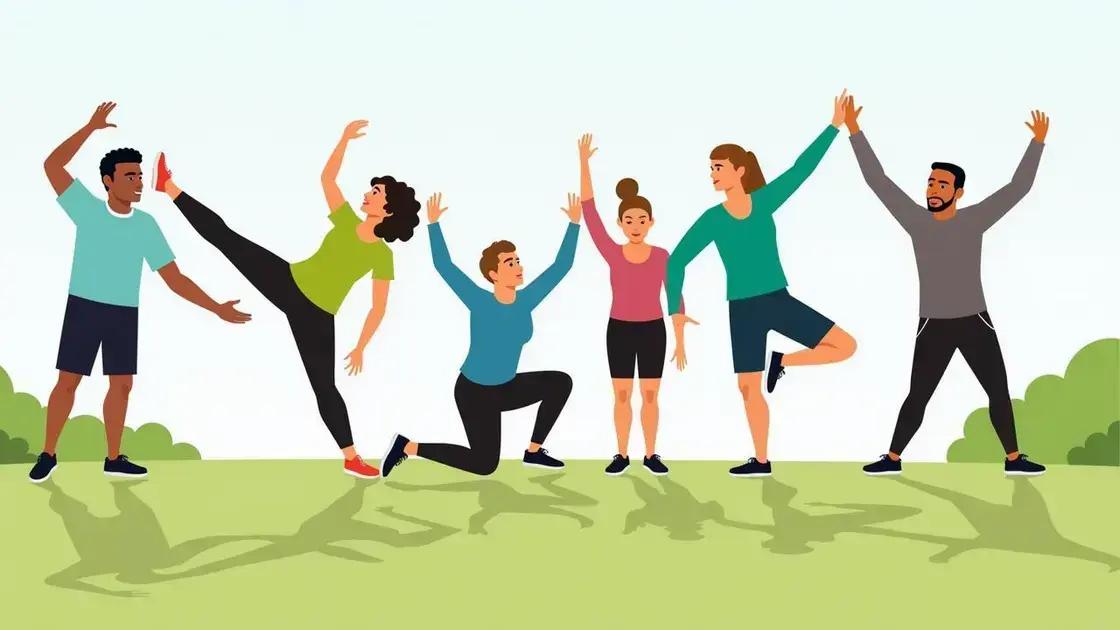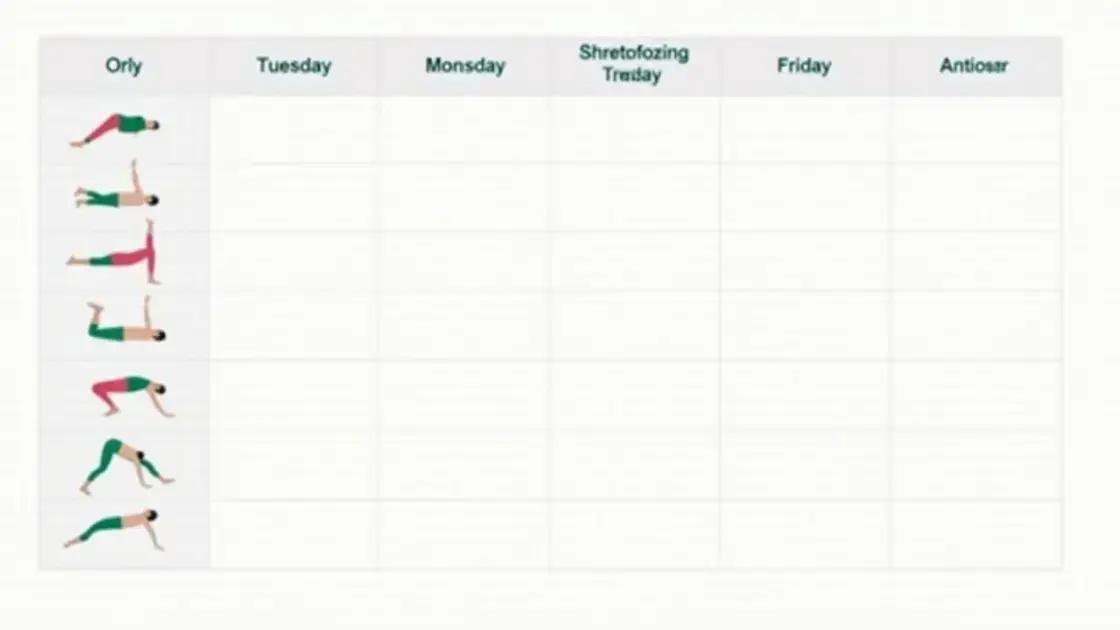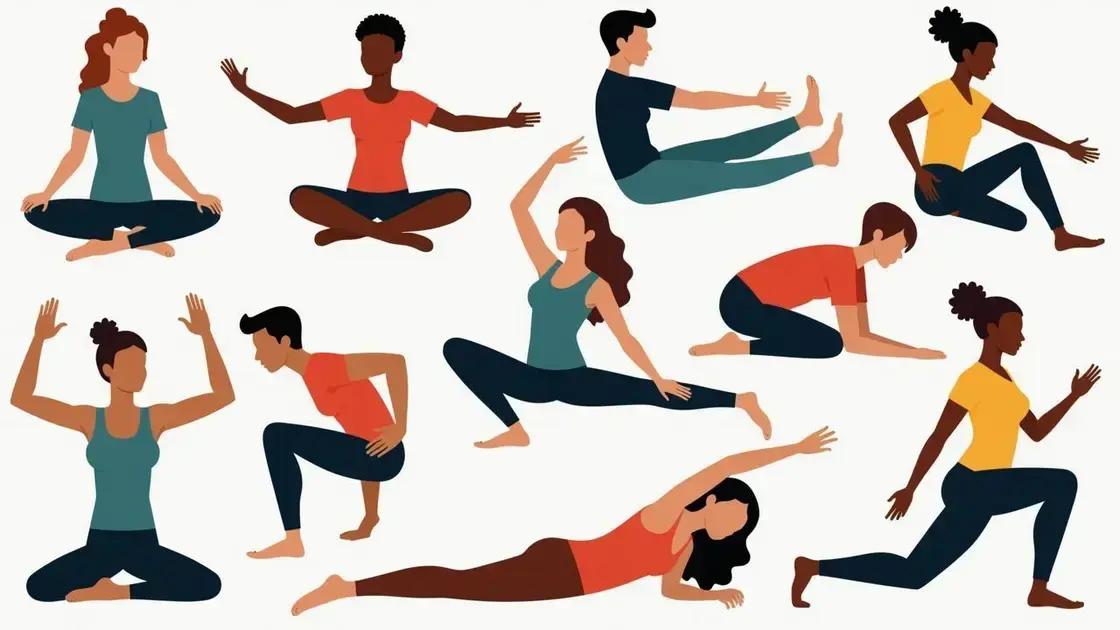Incorporating stretching into your daily routine enhances flexibility, reduces muscle tension, improves blood circulation, and promotes mental well-being, making it essential for overall health.
Incorporating stretching into your daily routine can significantly enhance your overall health. Stretching not only improves flexibility but also reduces stress and muscle tension. This article will explore the importance of integrating stretching into your life, provide simple techniques to get started, and suggest how to create a sustainable schedule. With just a few minutes each day, you can unlock the numerous benefits of stretching that lead to a healthier lifestyle.
The Importance of Stretching Daily

Stretching daily is essential for maintaining overall health and wellness. Regular stretching helps increase blood flow to your muscles, enhancing flexibility and reducing the risk of injuries.
When you stretch every day, you prepare your body for physical activities. It warms up your muscles and joints, making movement easier and more efficient. Moreover, stretching can **alleviate tension** and **stress**, contributing to mental well-being.
Physical Benefits of Daily Stretching
One of the key benefits of daily stretching is improved flexibility. As we age, our muscles tend to tighten, which can limit our range of motion. Incorporating stretching into your routine can help maintain and even enhance your flexibility, making everyday tasks easier.
Another significant advantage is that it can lead to better posture. Stretching the muscles that are often tight due to sitting or poor posture can help realign your body, reducing back and neck pain.
Mental Benefits of Stretching
Stretching daily can also improve your mental focus. The mindfulness aspect of stretching allows you to connect with your body and clear your mind. This can lead to reduced stress and anxiety levels, enhancing your mood.
Making Stretching Part of Your Routine
To reap the many benefits of stretching, consider setting aside just a few minutes each day. Whether it’s during your morning routine, lunch break, or just before bed, finding a consistent time for stretching can help you stick with it. Try to include a variety of stretches to address different muscle groups.
Simple Stretching Techniques for All Levels

Incorporating simple stretching techniques into your daily routine is easy and beneficial for everyone, regardless of their fitness level. Here are a few effective stretches you can try:
1. Neck Stretch
To relieve tension in your neck, sit or stand tall. Slowly tilt your head to the right, bringing your ear toward your shoulder. Hold for 15-30 seconds and repeat on the left side. This stretch helps ease neck stiffness and tension.
2. Shoulder Stretch
For improving shoulder flexibility, bring your right arm across your body at shoulder height. Use your left hand to gently pull your right arm closer to your chest. Hold for 15-30 seconds and switch arms. This stretch can help reduce shoulder tightness.
3. Standing Quad Stretch
If you want to stretch your thighs, stand on one foot and grab your opposite ankle behind you. Gently pull your heel toward your buttocks while keeping your knees together. Hold for 15-30 seconds and switch legs. This stretch promotes flexibility in the quadriceps.
4. Hamstring Stretch
To stretch your hamstrings, sit on the floor with one leg extended and the other leg bent. Reach toward your toes on the extended leg. Hold for 15-30 seconds, feeling the stretch down the back of your leg. Repeat on the other side. This stretch improves the flexibility of the hamstrings.
5. Child’s Pose
For a full-body stretch that relaxes your back, kneel on the floor, sit back on your heels, and stretch your arms forward while lowering your torso. Hold this position for 30 seconds to relax your back and shoulders. This pose helps relieve tension in the spine.
Try incorporating these simple stretches into your daily routine to enhance flexibility, reduce tension, and promote overall wellness.
Creating a Stretching Schedule That Works

Creating a stretching schedule is vital to make stretching a regular part of your daily routine. Here are some steps to help you design a plan that works for you:
1. Assess Your Daily Routine
Start by examining your typical day. Identify times when you can easily fit in stretching. Morning, lunchtime, or before bed can be great options. Jot down these times to create your schedule.
2. Set Realistic Goals
It’s important to set achievable goals. Begin with just 5-10 minutes of stretching each day. As you become more comfortable, gradually increase the time. Remember, consistency is key!
3. Mix It Up
To keep it interesting, incorporate different stretching techniques. Alternate between static stretches, dynamic stretches, and yoga poses. This variety will keep you engaged and benefit different muscle groups.
4. Use Reminders
Set reminders on your phone or leave sticky notes around your home or workspace. These gentle nudges will help you remember to stick to your stretching schedule. Making it a habit takes time, so don’t be discouraged!
5. Evaluate and Adjust
Every few weeks, take a moment to evaluate how your stretching routine is working for you. Adjust the schedule as necessary to fit your changing lifestyle or needs. Flexibility in your stretching plan will help ensure long-term success.
By following these steps, you can create a stretching schedule that fits into your life and helps you reap the benefits of regular stretching.
Benefits of Regular Stretching for Health

Regular stretching offers numerous health benefits that enhance both physical and mental well-being. Here are some key advantages of making stretching part of your routine:
1. Improves Flexibility
One of the most noticeable benefits of regular stretching is increased flexibility. Over time, stretching helps lengthen muscles, making everyday movements easier. Improved flexibility can also enhance your performance in sports and exercises.
2. Reduces Muscle Tension
By stretching regularly, you can relieve muscle tension and tightness. This can lead to a decrease in discomfort, especially if you have a sedentary lifestyle. Reducing tension helps improve your posture and comfort throughout the day.
3. Enhances Blood Circulation
Stretching promotes better blood flow to your muscles and joints. Enhanced circulation delivers nutrients and oxygen more efficiently, which can accelerate recovery, reduce fatigue, and enhance overall performance.
4. Boosts Mental Health
Stretching is not just beneficial for the body; it also provides mental health advantages. Taking time to stretch can reduce stress and anxiety levels, promote relaxation, and improve your mood. Incorporating stretching into your daily routine encourages mindfulness.
5. Prevents Injuries
Regular stretching increases your range of motion, which can help prevent injuries during physical activities. By warming up your muscles and improving flexibility, you prepare your body for movement, reducing the chances of strains and sprains.
Making stretching a regular part of your routine enables you to enjoy these health benefits while improving your overall quality of life.
Incorporating Stretching into Your Daily Routine
Implementing a regular stretching routine can significantly enhance your overall health and well-being. By understanding the importance of stretching, utilizing simple techniques, and creating a consistent schedule, you can experience the numerous benefits stretching has to offer.
From improving flexibility and reducing muscle tension to enhancing mental health and preventing injuries, stretching is an accessible practice that anyone can benefit from. Set realistic goals and remain committed to including stretching in your daily life.
With time and practice, stretching can become a natural part of your routine, leading to a healthier, happier you.
FAQ – Frequently Asked Questions about Incorporating Stretching into Your Daily Routine
What are the benefits of stretching daily?
Daily stretching improves flexibility, reduces muscle tension, enhances blood circulation, boosts mental health, and helps prevent injuries.
How can I create a stretching schedule?
Start by identifying times in your daily routine when you can stretch, set realistic goals, and use reminders to stay consistent.
What are some simple stretching techniques for beginners?
Techniques such as neck stretches, shoulder stretches, and hamstring stretches are great for beginners and can be easily added to your routine.
When is the best time to stretch?
The best times to stretch are in the morning, before exercise, during breaks, or in the evening to help relax the body.
How long should I hold each stretch?
Aim to hold each stretch for 15-30 seconds to effectively improve flexibility and reduce tension.
Can stretching help with stress relief?
Yes, stretching can promote relaxation and reduce stress by allowing you to focus on your body and breathing.












